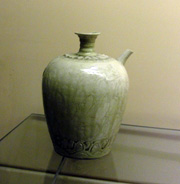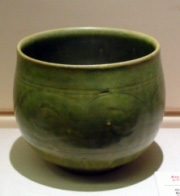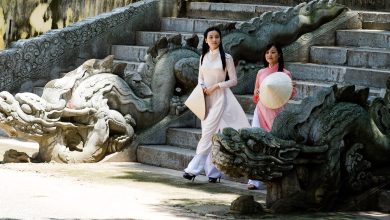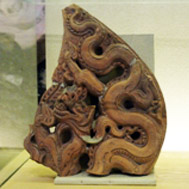Royal ceramics in the Imperial Citadel
Many royal pottery (used for daily activities of kings) have been found in the archaeological process in ruins at 18 Hoang Dieu (Ha Noi). The ceramic artifacts show that the level of processing ceramics of Thang Long craftsmen reached the peak of that period.
 The white and celadon enamelled ceramics dating from Ly Dynasty are really a big surprise to anyone by their sophistication. White enamelled ceramics under Ly Dynasty achieved the smoothness and shine as Song ceramics, which are known to reach the pinnacle of the art of pottery. The quality of white enamelled ceramics of Ly Dynasty and Song Dynasty were similar to the point that one could only distinguish between the two types through the darkness of the enamel color, ceramic bone or techniques designs. Celadon enamelled dishes engraved with daisy or lotus images were among the product group achieving equal level to Song Dynasty ceramics. These high quality ceramics had bold turquoise glaze and fine white ceramic bone. Waste pottery shards and pieces of wire daisy plates found in the archaeological process have helped scientists assert that white and celadon glazed pottery found here is the product of our craftsmen under Ly Dynasty.
The white and celadon enamelled ceramics dating from Ly Dynasty are really a big surprise to anyone by their sophistication. White enamelled ceramics under Ly Dynasty achieved the smoothness and shine as Song ceramics, which are known to reach the pinnacle of the art of pottery. The quality of white enamelled ceramics of Ly Dynasty and Song Dynasty were similar to the point that one could only distinguish between the two types through the darkness of the enamel color, ceramic bone or techniques designs. Celadon enamelled dishes engraved with daisy or lotus images were among the product group achieving equal level to Song Dynasty ceramics. These high quality ceramics had bold turquoise glaze and fine white ceramic bone. Waste pottery shards and pieces of wire daisy plates found in the archaeological process have helped scientists assert that white and celadon glazed pottery found here is the product of our craftsmen under Ly Dynasty.
Celadon enamelled ceramics were a beautiful type under Ly Dynasty. Decorations for these items normally associated with the subject of flowers or dragons which were very sophisticated and lively.
Royal ceramics under Ly Dynasty had elegant colors and decorations which were very sophisticated, refined beauty. The most widely used decorative images were still lotus, chrysanthemums, dragons, fairies, etc. These were the threads of Buddhist and very typical oriental colors.
 Tran Dynasty ceramics partly inherited from Ly Dynasty so basically they were similar to Ly Dynasty ceramics. However, ceramics under Tran Dynasty had their own distinctions, i.e. the type of blue flower pottery. This type mostly included dishes and bowls decorated with chrysanthemum flower, clouds, phoenix birds or flowers in brown iron or blue.
Tran Dynasty ceramics partly inherited from Ly Dynasty so basically they were similar to Ly Dynasty ceramics. However, ceramics under Tran Dynasty had their own distinctions, i.e. the type of blue flower pottery. This type mostly included dishes and bowls decorated with chrysanthemum flower, clouds, phoenix birds or flowers in brown iron or blue.
Under Le Dynasty, white enamelled royal pottery was decorated with dragons with 5 powerful sharp claws, the word Quan at the centre, and high-level blue flower pottery painted with dragons and phoenix with very fine lines which are assessed to reach the pinnacle of perfection. Thin white ceramics under Le Dynasty were mostly small plates, of which the ceramic bone was as thin as egg shell; the decorations inside could be seen when the ceramics were illuminated through. Embossed five claw dragons were the symbol of the imperial dragon, a clear sign to show royal pottery. The word Quan in the middle of the disk can be understood as the product of the oven or that used for the king and mandarins. Because the pottery was manufactured with very thin ceramic bone, they were very light.
Besides ceramics decorated with five claw dragons dedicated to the king, in the Hoang Dieu region, archaeologists also found a lot of pottery decorated with phoenix image, which were the belongings of queens.
In addition to bowls, plates, jars, pots, vases and lamp bases, archaeologists also found relatively intact lime-pots and betel chewing utensils. It shows that the custom of chewing betel was also popular in the palaces.





